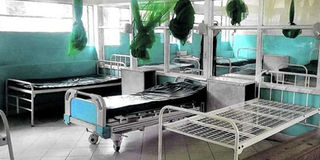Inpatient crisis: Public hospitals lose over 2,000 beds amid rising demand

Empty beds at Busia County Teaching and Referral Hospital.
What you need to know:
- Public hospitals, which are the primary source of care for the majority of Kenyans, experienced a reduction in bed capacity from 40,814 in 2023 to 38,552 in 2024 - a loss of over 2,200 beds in just one year.
The number of beds in Kenya's public hospitals declined significantly in 2024, exacerbating overcrowding, delayed admissions, and compromised care for vulnerable patients. This is despite a national increase of 15.5 per cent to 115,786 beds in both private and public hospitals.
According to the 2025 Economic Survey, public hospitals, which are the primary source of care for the majority of Kenyans, experienced a reduction in bed capacity from 40,814 in 2023 to 38,552 in 2024 - a loss of over 2,200 beds in just one year.
This situation has serious implications for patients who need to be admitted for surgery, maternity care, chronic disease management and recovery from serious illnesses.
"The number of hospital beds increased by 15.5 percent to 115,786 by 2024. Over the same period, the number of hospital cots increased by 9.6 per cent to 11,215," the statistics show.
The bed shortage affects vulnerable populations, particularly in rural and underserved areas, where public hospitals are often the only option. Mothers in maternity wards, accident victims and patients with chronic illnesses are all at greater risk.
In terms of cost, in-patient fees at private hospitals often run into tens of thousands of shillings, while public hospitals charge significantly less, making them the only viable option for most Kenyans.
Little improvement
Faith-based and Non-Governmental Organisation-run facilities, traditionally crucial in rural and marginalised regions, have seen little to no increase in bed numbers, compounding the challenges faced by the public sector.
The report shows that there has been little improvement in the availability of cots, which are essential for the care of newborns and infants, rising from 146 in 2023 to 185 last year.
Despite a slight increase in the overall number of cots, there are still not enough to meet the growing demand in maternity and paediatric wards. This shortage poses a direct threat to the health of vulnerable newborns and infants, and makes it difficult for hospitals to provide close monitoring and specialised care.
The declining capacity of public hospital beds and cots comes at a time when Kenya's population and healthcare needs are rapidly increasing.
According to the Kenya Health Facility Census Report, Kenya had a total of 140,000 available hospital beds in various categories, representing an average of 2.5 available beds per 1,000 people in 2023. The country has only 900 ICU beds, of which 779 are in government-owned facilities.
Similarly, only one in five facilities surveyed offered inpatient services, with the majority offering medical and paediatric inpatient services at 85 per cent and 69 per cent respectively. Less than a third (27 per cent) offered inpatient surgical services, and only four per cent of facilities offered inpatient oncology and psychiatric services.
Access to neonatal care in the country was equally low, at only 12 percent. Although the overall availability of equipment in facilities offering neonatal services is good, only about half of these facilities had CPAP machines (continuous positive airway pressure) available for neonatal care.
With Kenya’s population growing rapidly, the loss of public beds threatens universal health coverage goals. Without immediate action, preventable deaths—especially among mothers, newborns, and chronic disease patients—will rise
[email protected]


